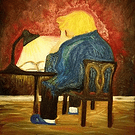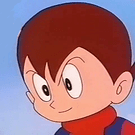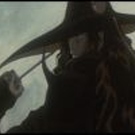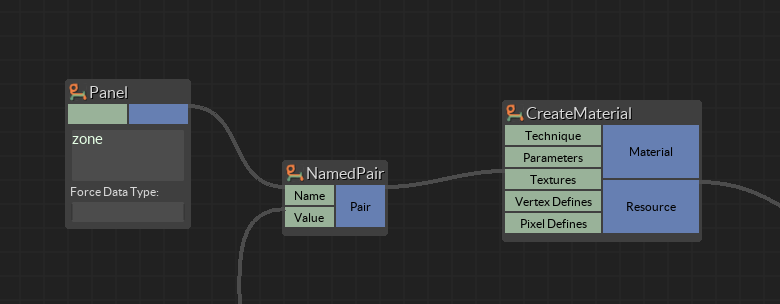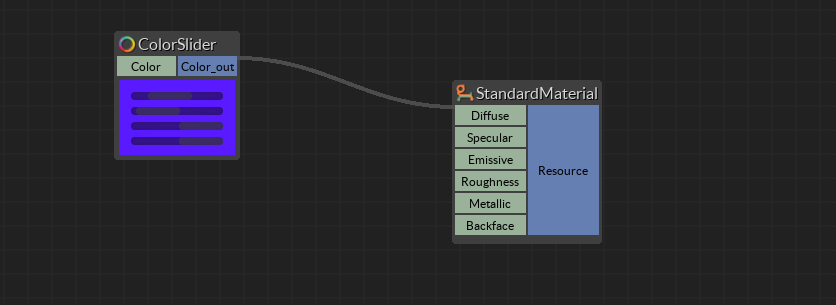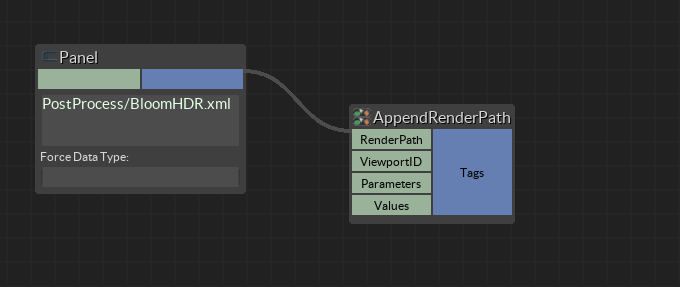I’m trying to implement a depth of field post processing shader. From the interwebs, I found this approach:
#include "Uniforms.glsl"
#include "Samplers.glsl"
#include "Transform.glsl"
#include "ScreenPos.glsl"
#include "Lighting.glsl"
varying vec2 vScreenPos;
varying vec2 vTexCoord;
varying vec2 vScreenPosFull;
#ifdef COMPILEPS
uniform float cBlurClamp; // max blur amount
uniform float cBias; //aperture - bigger values for shallower depth of field
uniform float cFocus; // this value comes from ReadDepth script.
#endif
void VS()
{
mat4 modelMatrix = iModelMatrix;
vec3 worldPos = GetWorldPos(modelMatrix);
gl_Position = GetClipPos(worldPos);
vScreenPos = GetScreenPosPreDiv(gl_Position);
vTexCoord = GetQuadTexCoord(gl_Position);
vScreenPosFull = GetScreenPos(gl_Position).xy;
}
void PS()
{
float aspectratio = 800.0/800.0;
vec2 aspectcorrect = vec2(1.0,aspectratio);
aspectcorrect *= 0.1;
float depth = 100.0 * DecodeDepth(texture2D(sDepthBuffer, vTexCoord).rgb);
float factor = ( depth - cFocus );
vec2 dofblur = vec2 (clamp( factor * cBias, -cBlurClamp, cBlurClamp ));
vec4 col = vec4(0.0);
col += texture2D(sDiffMap, vScreenPos);
col += texture2D(sDiffMap, vScreenPos + (vec2( 0.0,0.4 )*aspectcorrect) * dofblur);
col += texture2D(sDiffMap, vScreenPos + (vec2( 0.15,0.37 )*aspectcorrect) * dofblur);
col += texture2D(sDiffMap, vScreenPos + (vec2( 0.29,0.29 )*aspectcorrect) * dofblur);
col += texture2D(sDiffMap, vScreenPos + (vec2( -0.37,0.15 )*aspectcorrect) * dofblur);
col += texture2D(sDiffMap, vScreenPos + (vec2( 0.4,0.0 )*aspectcorrect) * dofblur);
col += texture2D(sDiffMap, vScreenPos + (vec2( 0.37,-0.15 )*aspectcorrect) * dofblur);
col += texture2D(sDiffMap, vScreenPos + (vec2( 0.29,-0.29 )*aspectcorrect) * dofblur);
col += texture2D(sDiffMap, vScreenPos + (vec2( -0.15,-0.37 )*aspectcorrect) * dofblur);
col += texture2D(sDiffMap, vScreenPos + (vec2( 0.0,-0.4 )*aspectcorrect) * dofblur);
col += texture2D(sDiffMap, vScreenPos + (vec2( -0.15,0.37 )*aspectcorrect) * dofblur);
col += texture2D(sDiffMap, vScreenPos + (vec2( -0.29,0.29 )*aspectcorrect) * dofblur);
col += texture2D(sDiffMap, vScreenPos + (vec2( 0.37,0.15 )*aspectcorrect) * dofblur);
col += texture2D(sDiffMap, vScreenPos + (vec2( -0.4,0.0 )*aspectcorrect) * dofblur);
col += texture2D(sDiffMap, vScreenPos + (vec2( -0.37,-0.15 )*aspectcorrect) * dofblur);
col += texture2D(sDiffMap, vScreenPos + (vec2( -0.29,-0.29 )*aspectcorrect) * dofblur);
col += texture2D(sDiffMap, vScreenPos + (vec2( 0.15,-0.37 )*aspectcorrect) * dofblur);
col += texture2D(sDiffMap, vScreenPos + (vec2( 0.15,0.37 )*aspectcorrect) * dofblur*0.9);
col += texture2D(sDiffMap, vScreenPos + (vec2( -0.37,0.15 )*aspectcorrect) * dofblur*0.9);
col += texture2D(sDiffMap, vScreenPos + (vec2( 0.37,-0.15 )*aspectcorrect) * dofblur*0.9);
col += texture2D(sDiffMap, vScreenPos + (vec2( -0.15,-0.37 )*aspectcorrect) * dofblur*0.9);
col += texture2D(sDiffMap, vScreenPos + (vec2( -0.15,0.37 )*aspectcorrect) * dofblur*0.9);
col += texture2D(sDiffMap, vScreenPos + (vec2( 0.37,0.15 )*aspectcorrect) * dofblur*0.9);
col += texture2D(sDiffMap, vScreenPos + (vec2( -0.37,-0.15 )*aspectcorrect) * dofblur*0.9);
col += texture2D(sDiffMap, vScreenPos + (vec2( 0.15,-0.37 )*aspectcorrect) * dofblur*0.9);
col += texture2D(sDiffMap, vScreenPos + (vec2( 0.29,0.29 )*aspectcorrect) * dofblur*0.7);
col += texture2D(sDiffMap, vScreenPos + (vec2( 0.4,0.0 )*aspectcorrect) * dofblur*0.7);
col += texture2D(sDiffMap, vScreenPos + (vec2( 0.29,-0.29 )*aspectcorrect) * dofblur*0.7);
col += texture2D(sDiffMap, vScreenPos + (vec2( 0.0,-0.4 )*aspectcorrect) * dofblur*0.7);
col += texture2D(sDiffMap, vScreenPos + (vec2( -0.29,0.29 )*aspectcorrect) * dofblur*0.7);
col += texture2D(sDiffMap, vScreenPos + (vec2( -0.4,0.0 )*aspectcorrect) * dofblur*0.7);
col += texture2D(sDiffMap, vScreenPos + (vec2( -0.29,-0.29 )*aspectcorrect) * dofblur*0.7);
col += texture2D(sDiffMap, vScreenPos + (vec2( 0.0,0.4 )*aspectcorrect) * dofblur*0.7);
col += texture2D(sDiffMap, vScreenPos + (vec2( 0.29,0.29 )*aspectcorrect) * dofblur*0.4);
col += texture2D(sDiffMap, vScreenPos + (vec2( 0.4,0.0 )*aspectcorrect) * dofblur*0.4);
col += texture2D(sDiffMap, vScreenPos + (vec2( 0.29,-0.29 )*aspectcorrect) * dofblur*0.4);
col += texture2D(sDiffMap, vScreenPos + (vec2( 0.0,-0.4 )*aspectcorrect) * dofblur*0.4);
col += texture2D(sDiffMap, vScreenPos + (vec2( -0.29,0.29 )*aspectcorrect) * dofblur*0.4);
col += texture2D(sDiffMap, vScreenPos + (vec2( -0.4,0.0 )*aspectcorrect) * dofblur*0.4);
col += texture2D(sDiffMap, vScreenPos + (vec2( -0.29,-0.29 )*aspectcorrect) * dofblur*0.4);
col += texture2D(sDiffMap, vScreenPos + (vec2( 0.0,0.4 )*aspectcorrect) * dofblur*0.4);
gl_FragColor = col/41.0;
gl_FragColor.a = 1.0;
}
It works ok, but I’m not sure I like how distinct the overlays are (i.e. its not blurry enough…). Anyone have any experience with this type of shader?
Also, I’m pretty sure I can get the current viewport dimensions in the fragment shader, but can’t remember how. Is int ScreenPos()?
